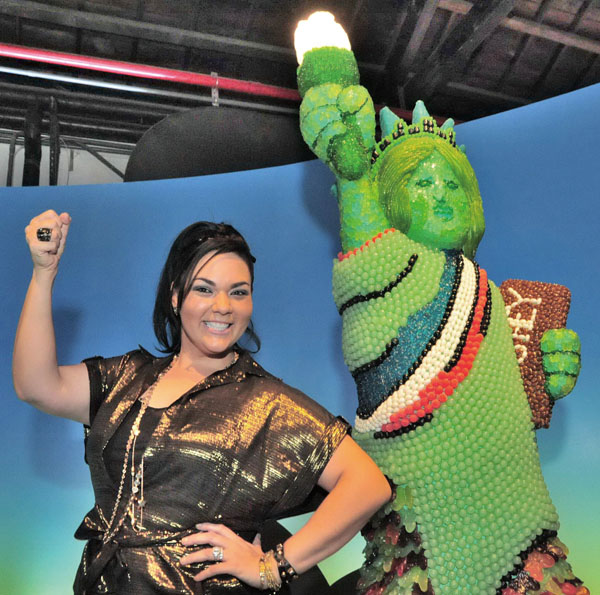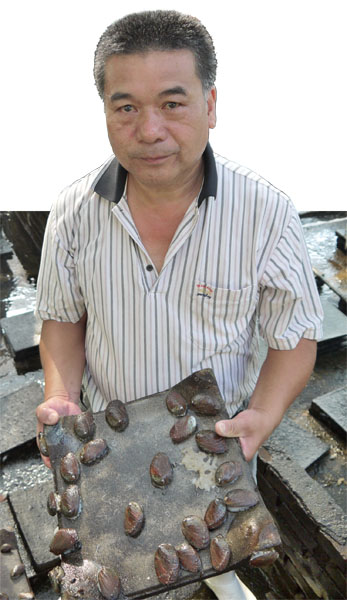Friend from afar — Jackie Sorkin, Candy Queen from Hollywood/有朋自遠方來 好萊塢糖果天后Jackie Sorkin
Friend from afar — Jackie Sorkin, Candy Queen from Hollywood
◎English translation by Lin Fu-ju ◎Photo by Pao Chung-hui
Jackie Sorkin, the Candy Queen from Hollywood, is having a sweet and colorful exhibition of 38 candy sculptures made out of 300,000 pieces of candy at Pier-2 Art Center. The exhibition will continue until April 21. Children and adults who have visited the exhibition have all enjoyed the cheerful energy of the candy.
Twenty staff members were mobilized and preparations for the exhibition took over four months. Each sculpture comes with a description noting the types of candy used and the number of candies each exhibit contains. Jackie likes to use traditional methods to execute certain things, so she designates people to keep records of each exhibit. The production team must pay close attention to detail.
When asked how to create a flourishing company, Jackie humorously said she does not have a degree from a candy university. She is completely self-taught. She also thanked her husband for his support. In 2009, her husband was laid-off and with no savings, Jackie began to sell her ideas and promote herself. This passionate CEO of the candy empire started her business with a family party and a US $400 budget.
 Jackie gives every job her all. Today, her client list includes entertainment giants such as Oprah Winfrey and Disney. Jackie believes her clients hire her because they believe she is an interesting and cool person. She encourages people to embrace work with enthusiasm and believe in themselves. In her opinion, a lot of people have a lot of ideas, but it is important to carry them out.
Jackie gives every job her all. Today, her client list includes entertainment giants such as Oprah Winfrey and Disney. Jackie believes her clients hire her because they believe she is an interesting and cool person. She encourages people to embrace work with enthusiasm and believe in themselves. In her opinion, a lot of people have a lot of ideas, but it is important to carry them out.
Accompanied by her parents and collogues, this is Jackie's first visit to Asia. They are a close-knit group and have really enjoyed seeing how the local people live. They jog by the Love River, have visited Fo Guang Shan, tried buns, dim-sum, ramen and hot stir-fried dishes. Jackie was very happy about the enthusiastic responses that she has received from the people in Kaohsiung towards the exhibit. She has been so touched by the people's kindness that she plans to extend her business in Asia and have a home here.
有朋自遠方來 好萊塢糖果天后Jackie Sorkin
◎文/侯雅婷 ◎攝影/鮑忠暉
「好萊塢糖果天后」Jackie Sorkin 4月21日前在高雄駁二藝術特區,展出以30萬顆糖果創造出甜蜜繽紛的38件糖果雕塑,前來參觀的大、小朋友彷彿感染了糖果的快樂能量,樂陶陶地探索著。
Jackie表示,這場展覽動員了20名工作人員,耗時4個月。每件作品都會載明使用了哪種糖果以及數量,Jackie說有些事情她喜歡用傳統的方法來執行,因此有專人負責計算,Jackie要求製作團隊每件事都要講究細節。
當被問起,如何開創出如日中天的糖果事業?Jackie幽了自己一默說,她並沒有糖果大學的學歷,一切都靠自學而來,她感性地謝謝先生的支持。她談道,2009年,先生失業,夫妻倆在沒有存款的情況下,Jackie開始推銷她的點子,同時也推銷她自己,這位充滿熱情活力的糖果公司執行長,從接下第一筆美金400元的家庭聚會開始,總是全力以赴,到今天,客戶包括好萊塢的歐普拉和迪士尼等。Jackie表示,要讓客戶相信妳是有趣且很酷的人,才會願意把事情交付予妳,她強調,要對工作懷抱著熱情以及相信你自己。Jackie說,很多人有很多想法,但是要設法去實踐夢想,短短一席話,道出成就一番事業的熱情。
此行是Jackie首次造訪亞洲,同行的還有Jackie的父母親和有如家人般的工作夥伴,一行人在愛河畔跑步,也造訪了佛光山,大啖100元熱炒店、包子、飲茶和拉麵,體驗自在的庶民生活。她非常開心地表示,高雄民眾對她的作品熱情的回應,著實讓她感動萬分,也悄悄地許下心願,希望能在亞洲成功發展事業,擁有一個家。
Linyuan's Mini-Abalone Expert: Lin Sheng-mo
◎English translation: Peng Hsin-yi ◎Photo by Lu Yi-ru
Linyuan, one of Kaohsiung's coastal districts, is famous for mini-abalone aquaculture. But it was not always so, and the man who started it all is not even a native of Kaohsiung. Mr. Lin Sheng-mo grew up in Taiwan's northeast, and got his start in the mini-abalone business when he was 18. He was so passionate about the trade that he traveled all over Taiwan, searching for the ideal environment. He settled in Kaohsiung, becoming the first mini-abalone farmer in Linyuan. He eventually became an authority revered by his peers.
The heyday of Kaohsiung's mini-abalone industry was around 2001, when as many as 200 farmers worked to give this part of Taiwan a greater mini-abalone output than any other city or county in Taiwan. But then a virus hit. Almost the entire crop was wiped out, and the number of mini-abalone farmers in Kaohsiung fell to just 10. Even Mr. Lin was unable to save his crop and he stopped farming for four years. But he loved his work and tried again. This time, he chose to raise mini-abalone in a more eco-friendly way, bearing in mind not only the health of his crop, but also the health of consumers and nearby ecosystems.
Mr. Lin's abalone farm is about 1000 ping (about a third of a hectare or 35,580 square feet) and divided into several sections for abalones at different stages of growth, from babies to fully grown, ready-for-market gastropods. He not only sells grown abalone to consumers, but also supplies youngsters to his fellow farmers. His farming pools have been designed to resemble the abalones' natural habitat as much as possible, and he keeps the population density low to reduce the risk of a mass die-out. Each pool is around 20 ping (approximately 771 square feet) and lined with cement cubes. The abalones live right under these cubes. Mr. Lin draws seawater from tidal flats 400m (a quarter of a mile) from his farm, and the water is tested regularly to ensure its quality before being released into the pools. Mr. Lin has invested in a water-recycling system; the water he draws from the ocean is used at least four times: first it reaches the abalone pools; from there it goes to fish pools; and then to algae pools (abalone food); and to fish pools again, before being discharged. Baby snails take about one year to grow to full size, and they weigh about 20g each (0.7 oz) when harvested.
 Mr. Lin jokes that he loves this business so much because it is a lazy man's dream job. After all, adult abalones need only be fed once a week. But, in fact, he is at the farm day in and day out, even if the weather is hot or rainy. It appears easy; Mr. Lin only needs take one look at the pool and sniff the water to know if everything is well. But this ability took him 38 years of hard work to cultivate, and is unequaled. As a veteran in the aquaculture business, Mr. Lin said he is happiest when working on his farm. He believes there is always a market for high-quality seafood and the future is going to be better and brighter.
Mr. Lin jokes that he loves this business so much because it is a lazy man's dream job. After all, adult abalones need only be fed once a week. But, in fact, he is at the farm day in and day out, even if the weather is hot or rainy. It appears easy; Mr. Lin only needs take one look at the pool and sniff the water to know if everything is well. But this ability took him 38 years of hard work to cultivate, and is unequaled. As a veteran in the aquaculture business, Mr. Lin said he is happiest when working on his farm. He believes there is always a market for high-quality seafood and the future is going to be better and brighter.
林園九孔養殖第一人林勝謀
◎文/侯雅婷 ◎攝影/盧怡如
從18歲開始養殖九孔,為了找尋最適合九孔的養殖環境,林勝謀一路從東北角搬遷至台東,最後在高雄林園區落地生根,成為林園區第一個九孔養殖戶,也是當地九孔養殖業推手。
高雄九孔養殖業於全盛時期(2001年),最高記錄有200多家養殖戶,產量居全台之冠,但受到外來病毒入侵,衝擊甚巨,林勝謀因此一度中斷九孔養殖4 年,高雄九孔養殖業者迄今遽減至10戶,但他對九孔有放不下的感情,堅守熟悉的老本行,朝精緻、健康和環保的方向養殖,並以取得認證為目標。
林勝謀1千坪的九孔養殖場進行從育種到幼貝、乃至於成貝一整個完整流程,販售九孔幼貝與成貝。他的九孔養殖,從水質到養殖環境,儘可能營造仿自然海岸邊的養殖環境,採平面式養殖,其優點為低密度養殖,能降低養殖風險。每池20坪,池內設置一塊塊四方形的水泥塊,使九孔附著於水泥塊底下。自4百尺外取得東北角潮間帶海水,通過檢驗的水方能用於池內,成貝養殖時間約為一年,約重20公克,即可採收。他的養殖池致力於水資源再生利用,歷經4次使用後的海水才會排出場外,順序為:九孔池、魚池、海藻池(九孔成貝的食物)、魚池。
林勝謀打趣說,成貝一星期只需餵養一次海藻,所以這行稱得上是懶人養殖,日曬雨淋,只見他在池內巡視著,只消看一眼,聞聞味道,他立刻知道這池九孔狀況是否一切正常,這把工夫花了他38年,老前輩篤定地說,從事這行讓他感到快樂,優質的水產品永遠能創造市場。